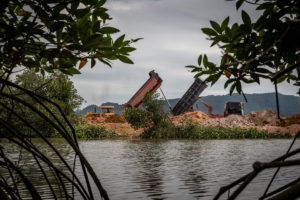Indonesia has been trying to boost the use of electric vehicles (EVs), with an eye to easing its dependency on fossil fuels. However, while the grid is powered by coal, this won’t work.
Since 2019, the government has issued several policies to support the EV sector, targeting public transport and more recently motorbikes and cars.
At a “fun day” designed to promote EVs in Jakarta last November, Budi Karya Sumadi, transport minister, explained that the government’s strategy is to electrify public transport and government vehicles, and increase the number of charging stations and battery exchange facilities. On 21 March this year, the government announced a range of incentives to encourage EV take up, including subsidies and tax breaks.
According to transport ministry data, the EVs registered in the country in 2022 comprised 22,942 motorbikes, 4,904 four-wheeled passenger vehicles, 280 three-wheelers, 56 buses and six cargo vehicles.
The energy ministry is targeting at least two million electric cars and 13 million electric motorbikes by 2030.
Budi Prawara, head of the Electronics and Informatics Research Organisation at the National Research and Innovation Agency, said there is a growing awareness among consumers of the efficiency of EVs and the need to reduce pollution from vehicles.
The global trend is EV growth. In 2021, the number of EVs on the roads had tripled compared to 2018, according to the Global EV Outlook 2022.
Dirty grid
In November 2022, Indonesia agreed a US$20 billion package of financial support from developed countries, led by the US and Japan, at the G20 Summit in Bali. The Just Energy Transition Partnership, as it is known, is expected to help Indonesia expedite its transition away from coal power and towards low-carbon alternatives.
The details are still being worked out, but the partnership aims to peak total power sector emissions by 2030 and reach net-zero emissions in the sector by 2050, bringing forward the country’s net-zero power sector emissions target by 10 years. The government plans to accelerate the deployment of renewable energy, aiming for at least 34% of all power generation to come from renewables by 2030.
However, critics see loopholes in the agreement that mean the country will continue to develop coal power, undermining potential benefits such as emissions reductions and cleaner air, that could result from a switch to EVs.
Under the partnership, Indonesia has agreed to halt the pipeline of planned on-grid coal plants included in its Electricity Supply Business Plan 2021–2030. Yet, as Dr Achmed Shahram Edianto, Asia electricity analyst at Ember point outs, there is no requirement to freeze coal plants already under construction or “captive” off-grid plants that serve industry.
There are “too many exceptions,” says Rere Christanto, mining and energy campaign manager at NGO the Indonesian Forum for the Environment (WALHI). He points to the “exclusion of all power plants that support national strategic projects. In addition, there is no explanation about the power plants’ early retirement scheme.”
As of January this year, the capacity of coal-fired power plants operating in Indonesia was 40.6 gigawatts (GW), an increase of 54% from 2015. According to the Electricity Supply Business Plan, this will increase further by 2030 with the construction of 13.8 GW of coal power plants.
The plan projects a significant portion of power capacity to be “new” and renewable energy, amounting to 20.9 GW or the equivalent of 51.6% of installed capacity. But the projected new coal-fired power capacity pushes the plan away from the goal of reducing emissions.
“The plan is greener but not green” said Tata Mustaya, head of the climate and energy campaign at Greenpeace Indonesia.
“A 42% portion for [coal] power plants… is going to weigh us down in the next 30-40 years,” Mustaya added. “We should move faster to stop the climate crisis.”
Emission reduction vehicles
Indonesia’s transportation sector accounted for 157 million tons of CO2 in 2019, or 27% of national emissions. The sector consumes more energy than any other, accounting for 45.8% of the national total in 2021, according to energy ministry data.
Indonesia’s primary energy consumption depends heavily on fossil energy, which accounts for 90%, split between coal (40%), oil (33%) and gas (17%), according the BP Statistical Review of World Energy 2022.
The energy transition provides a means to escape from these problems. Indonesia will reduce greenhouse gas emissions by 31.9% on its own or 43.2% with international assistance by 2030, according to the new climate plan it submitted to the UN in September 2022. In addition, the country is targeting net zero emissions in 2060 or sooner.
The energy ministry believes that switching to EVs will be necessary if these climate commitments are to be achieved. Based on its calculations, replacing one million oil-fuelled cars with EVs by 2025 would reduce CO2 emissions by 3.2 million tonnes per year. Meanwhile, replacing 900,000 motorbikes with electric models would reduce emissions by 0.6 million tons/year.
“If 140 million oil-fuelled vehicles are replaced with electric vehicles, each year we reduce emissions by 100 million tons of CO2,” said Arifin Tasrif, energy minister, in Jakarta, on 20 November 2022.
There is a contradiction in the electric vehicle project. This is because about 60% of the primary energy source is still based on coal.Bhima Yudhistira, executive director of Center of Economic and Law Studies
According to Tasrif, the transition to EVs is important because the number of oil-fuelled vehicles is increasing, and with it the demand for oil. According to data from the energy ministry, Indonesia’s oil reserves are expected to last another 9.5 years.
“Unlike the demand for fuel oil, which has increased, national oil and gas [extraction] continues to decline because the wells are old. So, our imports are increasing, and the subsidies are getting bigger,” said Arifin.
In September 2022, President Joko Widodo announced an increase in the fuel subsidy and compensation budget. This is because, this year, the amount reached 502.4 trillion Indonesian rupiah (US$33 billion), or increased three times. The president said that the increase still has the potential to occur in the future.
Clean transport needs a clean grid
Bhima Yudhistira, executive director of research group the Center of Economic and Law Studies (CELIOS), wants the government to phase out coal energy and increase investment in renewables. Early retirement of coal-fired power is believed to be the most effective way to reduce emissions.
He cites a report by the Asian Development Bank stating that accelerating the termination of coal-fired power plants similar to Cirebon-1, a 660 megawatt plant in West Java, can reduce greenhouse gas emissions by up to 30 million tons, which is equivalent to removing 800,000 cars from the roads.
“So, if we want to reduce emissions by eight million tons of CO2… we only need to close 10 coal power plants of the same class as Cirebon-1,” said Yudhistira.
“There is a contradiction in the electric vehicle project,” he said, referring to the country’s dependence on coal. “If this is not changed, then emissions from motorised vehicles will shift to power plants,” he added.









